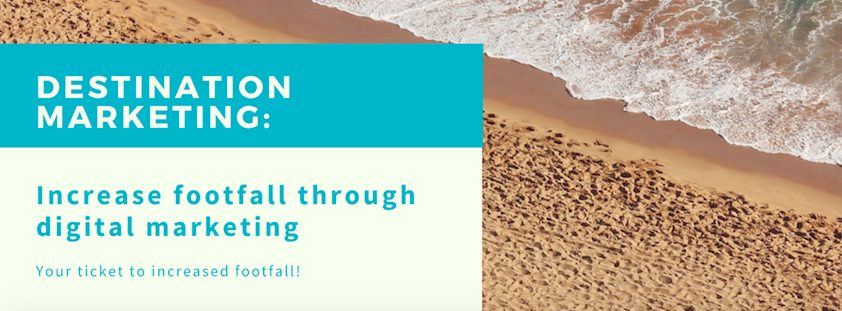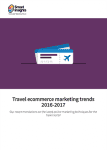The must-know essentials to increasing your footfall through destination marketing online
If you work in the destination sector, you’ll ultimately be judged on ticket sales. We notice time and time again that the leisure and tourism attractions that smash their ticket-sales targets are the ones that fully understand (and influence) the modern consumer’s reliance on the internet when booking holidays or days out.
Today’s consumer will turn to the internet to research where to go, what attractions to visit whilst there, where to avoid, and what events coincide with their stay.
It’s your job as a destination marketer to get your attraction noticed during this research stage. This article will teach you how and will include details on how and why you need to…
- Create buyer personas
- Work from a content calendar
- Influence each stage of the buyer’s journey
- Employ the right tactics
- Ensure your website is traffic-friendly
1) Devise Destination-Based Buyer Personas
Trust us: understanding your audience is the first step towards creating a winning destination marketing strategy. To understand how to attract your audience, you first need to define who they are. Are your key demographics millennials, couples, seniors, families?
Reason being, when you’ve pinpointed exactly who you’re trying to attract, it becomes that much easier to:
- Appeal to this audience
- Directly address their concerns, needs, or reservations about a day-out or trip
- Resonate in the online spaces your demographic ‘hangs out’ in
- Attract potential customers who might not have heard of you
- Reactivate those who have heard of you
Ultimately, you need to create a buyer persona.
2) Create a Destination Marketing Content Calendar
Now you know what makes your audience tick, use this information to your benefit and create content that edges them along the buyer’s journey.
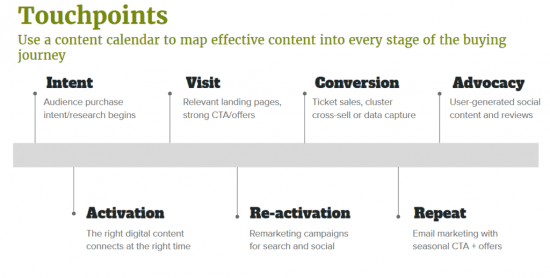
It might not seem sexy, but putting your efforts down in a calendar will allow you to:
- Stay on track with your proposed marketing efforts
- Promote events in a timely manner
- See, on a top-level basis, whether your content is catering to all of your personas
Sound good? This content calendar planning template is a great way to get started.
3) Influence the Journey
Research Stage
So, you’ve created your buyer personas and you now know where on the internet your audience looks when planning a trip. Well, now you have to get content in these places.
The tactics and methods you use will be dictated by the audience you’re trying to attract; however, here are a few suggestions:
- Devising an Instagram strategy that utilises well-searched hashtags
- Outreaching to relevant travel/day-out sites
- Creating Pinterest boards that showcase your attraction
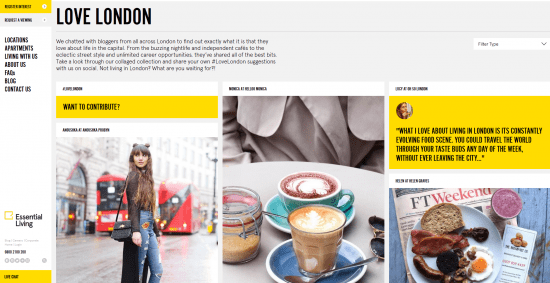
The campaign featured above sees Essential Living’s ‘Love London’ campaign promote the company’s new apartment block by creating high-quality, ‘local-only’ advice guides – featuring must-see bars, restaurants, and things to do. Much of the information was provided by local bloggers and businesses, so the result was a lot of traffic, brand recognition, and reach for the brand and its destination product.
Active Stage
In this stage, a user has found your site and is tempted to book, but still, needs a little convincing.
Successful marketing at this stage is providing the visitor will all the information they need to make them feel like they are making the right decision. This can include:
- Incorporating testimonials or TripAdvisor reviews onto your site
- Video or CGI content that gives people a feel for your attraction
- A detailed and easy-to-navigate FAQ section that covers all possible bases
Trust Stage
If someone has visited your attraction recently, you can gain leverage from the immediacy of their visit by following up with an email that does one of the following:
- Requests a review
- Pushes them to your social
- Encourages them to share any user-generated content (pics, videos, stories, competition entries)
- Promotes upcoming events or offers discount for return booking
Doing so develops your relationship with the customer and encourages them to share marketing collateral that you can use to attract first-time visitors to your resort.
4) Employ Tactics That Support Your Content Strategy
To fully enjoy the fruits of your labour, use digital marketing tactics that support your ‘buyer journey’.
Influencer Marketing
Team up with a destination-marketing influencer who is followed by a demographic similar to yours: one that is looking for holiday/day-out ideas. The content the influencer creates should be exciting, should show your attraction in a good light, and should thereby encourage visits.
Why not develop this idea by making a partnership with the blogger? Perhaps you could reach an arrangement in which the blogger is given a percentage of any ticket sales come through their site or social channels? This tactic makes it in the blogger’s interest to promote your resort as much as possible.
Outreach
As mentioned earlier, when creating buying personas, you will be left with a lot of sites that your audience frequents. Make a list of these sites and then ‘outreach’ to them. This means getting in touch with them and asking them to let you create either free or sponsored content to sit on their site – content that will interest their readers and link back to your site.
Keyword-Optimised Blogs
If people are travelling to an area, it’s likely that they’ll google around for things to do. Help stake your claim in the online real estate by using Google Keyword Planner to find the terms that people are searching for, and then create content that will rank and lead searchers to your site.
If it seems too much of a struggle to rank organically, put some budget behind a Google AdWords campaign to guarantee that your content will be targeted at the right people.
Another key idea is to show ads to people who have just arrived in your area. Facebook’s targeting setting lets you know users in your area that are travelling. Show them ads, because chances are these holidaymakers will be looking for things to do.
Get Social
Having a sophisticated social strategy is a great way of keeping your attraction front-and-center in people’s minds, even when they’re not directly looking for a day out.
Always Encourage User-Generated Content
Host competitions in which entries are comprised of stories or photos from your destination. This way you are enabling the creation of user-generated content that also acts as the social proof that may be needed to convince others that they are missing out by having not visited your attraction.
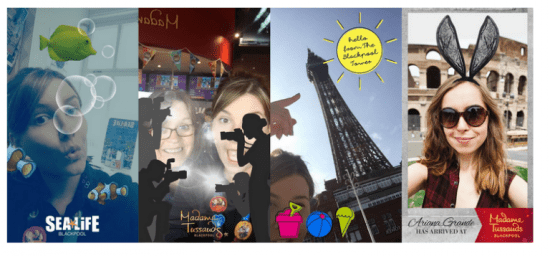
5) Get Your Website Right
Although in this article we’ve talked at length about understanding your audience, it is vital that you know the site that you’re pointing traffic to is good enough.
Imagine the frustration of driving highly relevant leads to your site, only for them to drop off due to poor user experience or technical issues.
A few valid points include…
- Checking that your page-speed is good enough (Google has a tool for this)
- Using a platform such as HotJar to gather insights into conversion hurdles
- Making a good impression in terms of aesthetics, content, and navigation
- Ensuring that metadata is correct and in-line with keyword research
Destination Marketing: Just the Ticket
So, there we have it. We hope you’ve found this article useful. In a nutshell, good destination marketing revolves around researching and knowing your audience, creating the content they need in all stages of the buyer journey, and then seeding and amplifying this content so that it is found by the right people at the right times.
If you crack this method, you can be sure to see footfall increase at your attraction.
AUTHOR BIO

Thanks to Michael Palmer for sharing their advice and opinions in this post. Michael Palmer is Head of Marketing at theEword You can follow him on Twitter or connect on LinkedIn
